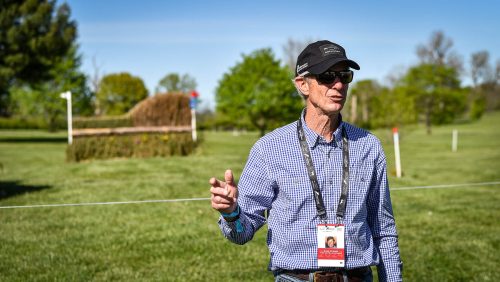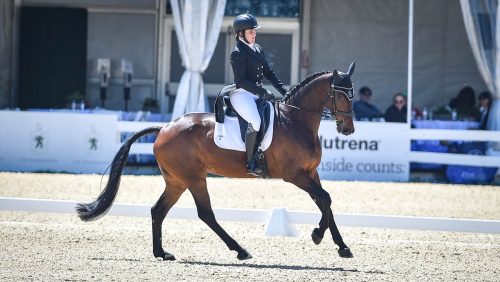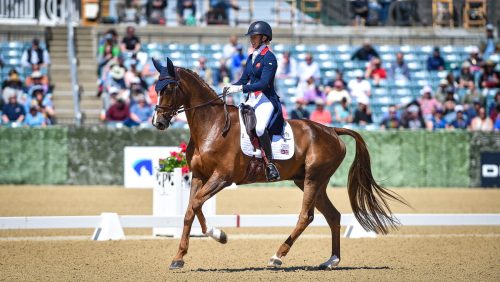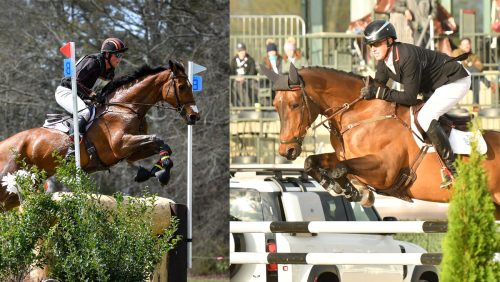Several years ago, two-time World Champion Bruce Davidson approached Jo Whitehouse, chief executive office of the U.S. Eventing Association, with the idea of starting a young event horse series modeled after the one held at Burghley Park, in the United Kingdom. Rather than breeders and trainers having to run their promising youngsters in regular low-level divisions with everyone else, why not form a class that would serve to highlight their possible four-star potential?
Hence, the young event horse series was launched in 2004, with five different show organizations in USEA Area II offering 4- and 5-year-old classes, which culminated in a year-end championship at Morven Park, Leesburg, Va., in November of that year. The series increased in popularity, and in 2005, there were 21 different venues hosting these classes nationwide, and there are a similar number scheduled for 2006.
Gaspar II, a warmblood gelding (Gigolo–Schatzeli), owned by the Luce-Segal Group, won the inaugural 5-year-old division under rider Darren Chiacchia. In 2006, he has now made the step up to advanced, completing the Jersey Fresh CCI*** (N.J.) this spring, and is an example of what this program is trying to produce.
The 4- and 5-year-old classes are broken down into four sections: conformation and type, dressage, jumping, and suitability and potential. The judging is structured to weigh each section differently: conformation and type is worth 15 percent, the dressage test is 35 percent, the jumping phase is 40 percent, and suitability and potential is 10 percent of the score.
In the first section, the horses are presented in hand, stood up and jogged for the judges. This is followed by the dressage test. A new test was written especially for these classes, to be judged by overall collective impression, rather than marks for individual movements. The jumping section takes place over a small course of natural show jumping fences, or a mixture of cross-country and natural show jumps. The fence heights range from 2’6″ to 2’11” for the 4-year-olds, and 2’11” to 3’3″ for the 5-year-olds.
Cross-country fences reflect those that you would find on an easy novice course and an easy training course, respectively. The course should have at least one bank, water, ditch or solid fence. An ideal course would be a mix of cross-country fences and show jumps, with six to eight jumping efforts in total and a good place to gallop at the end.
After the final jump, the horses are asked to gallop briefly, so the judges can assess their suitability and potential for the sport. Each section is scored on a scale of 1 to 10. The scores for each individual section are then compiled into a final point total. Two scores over 70 percent at two different events are necessary to qualify for the year-end championships, and there are typically two judges for each class.
So how do you go about establishing set conformational criteria for a sport that has been traditionally characterized by the wide physical variety of its participants?
George Murangh, of Tattersalls in Ireland, judged the inaugural championships. With his extensive experience with sport horse bloodstock, he helped to establish the criteria for judging.
“Clean, straight limbs, an uphill build, good feet, good wind and a good expression in the eye are all looked for in assessing conformation and type,” said Whitehouse. “The horse must also have the wind and stamina necessary to gallop cross-country.
“In the dressage phase,” she added, “the judges are looking for movement, suspension and relaxation. It’s scored on overall impression, not whether or not the horse performed his transitions at the correct markers. In the jumping phase, the judges are looking for the horse’s overall scope and ability, not whether the horse or rider miss at a jump and take it down.”
Major General Jonathan Burton, renowned horseman and one of the judges of last year’s championships, pointed out, “With the movement to the short format in the last several years, the horse we now look for to compete at the upper levels must be obedient, well balanced, with movement, elegance, and the agility and bravery to jump the big, technical courses. A greater level of control and adjustability is now needed.”
Standardization
Any new program generates some criticism, and the young event horse series is no exception. In a sport where subjectivity has been a factor in only one of the three phases, adjusting to being judged in all aspects of the class is taking some getting used to. Scores that have a huge range leave some competitors scratching their heads and wondering what the judges are really looking for.
ADVERTISEMENT
Another concern has been the variety of courses offered in the jumping phase. The guidelines offered by the USEA are broad enough to allow one venue to hold the class in a schooling field with a nice variety of natural fences and a big area to show off a horse’s gallop, while others might set up jumps in a ring and have the competitors gallop around the edge at the end for suitability judging.
Nina Gardner, an owner and breeder based in Pennsylvania, heads the task force that has been formed to address such issues. “The committee is aware of these concerns and is taking steps to remedy them,” she said. “In order to bring more standardization to the judging, we are preparing a packet to be given to the judges before each competition, outlining the established judging criteria for the series.”
Burton also noted the difficulty from a judge’s standpoint in trying to discern the horses’ potential ability while taking into account the quality of the ride it’s being given.
“The ability of the riders varies greatly and can make it difficult to assess the future potential of the horse,” he said.
Gardner acknowledged that at this point, there’s not a certification program in place for those who wish to judge, but such a program is certainly on the horizon.
As for any sort of standardization in the jumping phase, that’s simply going to take some time, as more organizations learn what it takes to put on a successful class.
“We don’t want to dis-courage event organizers from holding the classes, yet we want to gradually bring in a bit more conformity,” said Gardner. “Many of the proposed changes are going to take time.”
A Good Education
Colleen Hofstetter, Mars, Pa., owner of last year’s 5-year-old champion, Free And Clear, said the series was a good experience for her horse.
“You get so much more feedback on your horse from knowledgeable sources on all aspects of their performance, not just the dressage test,” she said. “It lets you know how your training program is working. By the end of the series, if you keep all your score sheets, you have a reference book on your horse’s conformation, suitability and jump ability.”
Hofstetter acknowledged that some of the judges’ opinions varied greatly on her horse, “but it all synthesized into logical feedback,” she said.
Free And Clear spent the winter following his championship win competing at novice and training levels. After a few runs at preliminary, he’s taking a short vacation while his rider, Phillip Dutton, concentrates on his upper-level mounts. Keith Douglas of Parodocs Farm bred Free And Clear in Canada. His sire is Mountain Pearl, an Irish Draught, and he’s out of Rare One, a Thoroughbred. Hof-stetter fell in love with his photo online and purchased him.
Past Olympian Phyllis Dawson, Purcellville, Va., has shown horses in the series all three years. In 2004, she trained Cyrrillic, a gelding she imported from Bulgaria, to reserve series champion 5-year-old, and Play Zone, an American Thoroughbred gelding, won the 4-year-old championship with Melissa Hunsberger in the irons. Both horses were sold following the series.
“The exposure in the classes certainly improved Play Zone’s salability,” said Dawson. “It’s a good way to show off your fancy young stock, and it’s a good education for the young horses.”
ADVERTISEMENT
Both horses are now competing at preliminary with their new owners.
Last year Dawson coached Pedro Guiterrez and his Mexican Thoroughbred stallion Orujo de la Galena (Agamemnon–Cartelera) to a close reserve placing in the championships behind Free And Clear. “Again, it was a very educational experience for the horse,” she said.
Alison Springer, rider of last year’s 4-year-old reserve champion, Folklore, said the program is a good way to promote “purpose-bred horses” for the sport.
“With the sport in transition, the horse of future upper-level competitions is going to look different from the horse of old,” she said. “The series helps to encourage better breeding for the sport.
“It’s a good way to showcase the young horses,” she added. “I show my young horses in the series in addition to competing them at the lower levels. It helps to round out their education. I encourage everyone with a nice young horse to try it.”
Looking Ahead
Whitehouse and the task force committee are working hard to make sure the future of the program continues to stay bright.
“The British Equestrian Federation has divided their program into two groups. They now have an age class that’s targeted toward the horses with potential international talent, and a second class to highlight those horses that will make outstanding amateur mounts,” said Whitehouse. “We would very much like to do something like that here. The numbers of entrants in the classes are increasing at such a rate as to suggest that this might be possible in the next few years.”
Another point of consideration is the height of the jumps. Currently, the 4-year-olds jump 2’11”, while the 5-year-olds jump 3’3″. There’s debate about whether or not these heights should be increased to 3’3″ and 3’7″, respectively.
“It’s a bit difficult,” said Whitehouse. “Some of the scopier horses need the bigger fences in order to show themselves off prop-erly. However, many owners are still concerned about pushing their nice young horses along too fast. We will have to work to find a happy medium.”
At MCTA Horse Trials (Md.) this spring, Dawson pointed out that within the course, the designer flagged two fences together, one side higher than the other, giving the competitors the option to choose which height to jump.
“It was a good idea,” she said. “It gave those with horses who are a bit more schooled the opportunity to show their horses off a bit more, without penalizing the horses who weren’t quite ready for that height.”
Dawson mentioned, from a trainer’s and competitor’s point of view, that it might be beneficial in the 4-year-old division to allow the horses to be shown the fences before being asked to jump the course, as they do in the young horse series in Ireland.
Gardner hopes that the growth of the series throughout the country will also fulfill a secondary goal: “The primary goal of the series is to highlight the potential four-star horses in the country. A secondary goal would be to help educate those who do not have access to professional help in what it takes to produce a nice young event horse.”
Young Event Horse Series Facts
Minimum height of horses is 15 hands.
Minimum age of riders is 14 years.
Riders are not required to be U.S. Eventing Association members, nor are horses required to be USEA registered.
Only snaffle bridles may be used.
The dress code is relaxed–collared shirts with sleeves, breeches andboots.
Lack of size or color in a horse should not be held against him.
In the dressage phase, the horse is not scored on obedience.
No gender discrimination–judges are cautioned about having any prejudices against mares.
Competitors in the series have included: Thoroughbreds, Irish Sport Horses, Clydesdale crosses, many different warmblood breeds and warmblood crosses.














